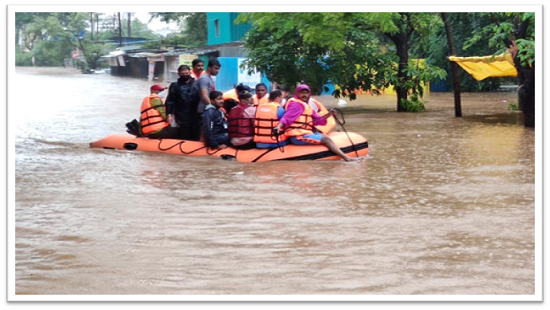
Building Agricultural Resilience, Maharashtra’s Constructive Approach to Post-Flood Recovery
In a decisive and compassionate move, the Maharashtra government has approved a ₹1,356.30 crore relief package for farmers impacted by the heavy rains and floods of September 2025. This timely intervention underscores the state’s commitment to agricultural resilience, rapid disaster response, and inclusive rural recovery.
The relief package, announced by Relief and Rehabilitation Minister Makarand Jadhav-Patil, aims to benefit over 21.66 lakh farmers across seven districts — Beed, Dharashiv, Latur, Parbhani, Nanded, Satara, and Kolhapur — covering a total of 15.16 lakh hectares of flood-damaged farmland.
Rather than a one-time aid, the package signals a deeper strategic intent: to stabilize rural livelihoods, restore productivity, and embed efficiency into Maharashtra’s disaster relief systems.
Targeted Relief Ensuring Equity and Efficiency
The government’s district-wise allocation reflects a data-driven and needs-based approach. Among the affected regions, Beed district—one of the most severely impacted—will receive the largest share of ₹577.78 crore, assisting over eight lakh farmers whose crops across 6.44 lakh hectares were destroyed.
Other allocations include:
• Dharashiv (₹292.49 crore) to support around four lakh farmers,
• Latur (₹202.38 crore) to aid four lakh cultivators across two lakh hectares,
• Parbhani (₹245.64 crore) benefiting 4.39 lakh farmers, and
• Nanded (₹28.52 crore) covering 83,000 affected farmers.
Smaller yet significant allocations have been made to the Satara (₹6.29 crore) and Kolhapur (₹3.18 crore) districts, ensuring that even moderately affected regions receive adequate support for recovery.
Such precision allocation—anchored in real-time damage assessment—demonstrates a shift from broad-brush relief policies to granular, evidence-based decision-making. It also reaffirms Maharashtra’s leadership in deploying data-backed governance in agriculture.
Reform in Relief Delivery - Decentralized and Time-Efficient
A notable reform in this package is the decentralization of compensation delivery. Minister Jadhav-Patil announced that payments for loss of lives, livestock, and homes will now be processed directly at the district level, removing the previous requirement of routing proposals through the state government.
This structural shift is more than administrative—it’s a policy innovation aimed at reducing bureaucratic lag and ensuring speedier relief distribution. By empowering district administrations, the government is enabling faster decision cycles, greater accountability, and localized transparency—elements essential for restoring trust in governance among rural citizens.
Such procedural clarity can make the difference between delayed aid and timely recovery, especially for small and marginal farmers whose livelihoods depend on immediate assistance.
Integrating Flood Relief with Long-Term Agricultural Policy
This package follows the government’s recent ₹31,628 crore comprehensive compensation program, designed to provide relief to farmers and citizens affected by widespread floods and incessant rains. Under that broader initiative, the state offers ₹47,000 in cash compensation and ₹3 lakh in employment aid per hectare of flood-damaged farmland through the NREGA (National Rural Employment Guarantee Act) framework.
Together, these measures represent a two-tiered relief architecture:
1. Short-term stabilization through direct monetary aid, and
2. Long-term resilience building through employment generation, land rehabilitation, and soil restoration.
This integrated model—combining fiscal support with livelihood creation—positions Maharashtra as a case study in adaptive disaster management.
Learning from the Crisis - A Path Toward Sustainable Preparedness
Deputy Chief Minister Devendra Fadnavis highlighted the scale of the disaster: 29 out of Maharashtra’s 36 districts and 253 of 358 talukas were impacted by the floods. Of the 1.43 lakh hectares sown at the start of the monsoon, 68 lakh hectares of crops were destroyed, while another 60,000 hectares suffered topsoil erosion.
These numbers underline the magnitude of vulnerability in Maharashtra’s agrarian landscape. Yet, they also emphasize the need for climate-responsive planning, modern irrigation infrastructure, and crop diversification.
While floods are a recurring natural phenomenon, their impact can be significantly mitigated through integrated water management, sustainable land-use practices, and early warning systems. The current relief package, therefore, should be seen not merely as compensation but as an investment in long-term agricultural sustainability.
From Relief to Resilience
The ₹1,356 crore relief package offers immediate financial security, but its true impact will depend on how effectively it is disbursed and monitored. Transparent tracking mechanisms, digital payment platforms, and local audits can ensure that every rupee reaches its intended beneficiary.
Moreover, integrating climate risk insurance, digitized land records, and community-led watershed programs into future policies will strengthen Maharashtra’s ability to bounce back from extreme weather events.
Equally important is the need to connect relief programs with innovation—encouraging adoption of drought- and flood-resistant crop varieties, promoting precision farming, and building farmer cooperatives that can collectively manage post-disaster rehabilitation.
A Constructive Step Toward Farmer-Centric Governance
The Maharashtra government’s ₹1,356 crore relief package is more than a response—it’s a reflection of adaptive governance in action. By combining immediate support with long-term sustainability goals, the state has set a benchmark for how agricultural recovery should look in the age of climate volatility.
Beyond numbers and allocations, what stands out in this announcement is a philosophical shift in governance. Maharashtra’s approach recognizes that farmers are not just recipients of aid but partners in progress. By linking relief to employment and recovery to empowerment, the state is building a more self-reliant and climate-resilient agricultural economy.
As India continues to face increasing climatic unpredictability, such proactive, structured, and empathetic policies can serve as blueprints for other states. They illustrate how effective governance, fiscal discipline, and human sensitivity can come together to turn a crisis into an opportunity for renewal.
With this initiative, Maharashtra isn’t merely rebuilding what was lost—it’s laying the foundation for a stronger, smarter, and more resilient rural future.